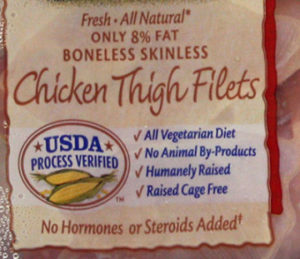“Natural”… “Humanely Raised”… “No Hormones or Steroids”
When it comes to our daily food choices, one of the biggest challenges is knowing whether you can trust what you buy. Food companies use positive sounding terms and claims about things like the environment or how farm animals are treated on food packaging to attract conscientious customers, just like you. The problem is these food label claims are often pretty confusing—and some are even purposefully misleading.
While some food label terms and claims are legally defined—and can only be used if specific rules are met—most of the food label claims you’ll see are completely unregulated, and open to abuse. But recent research shows even the regulated food label claims are not always properly policed or controlled. In many cases, the farmer or food producer simply has to sign a piece of paper (an affidavit) to say they’re following the rules, and that’s it. There’s no official inspection or audit of the farm or procedures to make sure they’re actually doing what they say they are!
Food You Can Trust?

Looking at this generic label for chicken thighs (right), let’s consider the commonly-found terms and claims it lists, including “All Natural,” “Humanely Raised” and “No Hormones or Steroids Added.” It all sounds positive, right?
But what do all the individual terms and claims on this label really mean? We think you’ll be surprised by the truth…
All Natural
Many consumers assume a “natural” label claim means the animals live outdoors. Yet it has nothing to do with how animals are raised and simply means the meat contains no artificial ingredients or added colors, and that it was minimally processed.
Humanely Raised
As there is no legal definition or minimum agreed welfare standard for the term “humane,” you’ll find this label claim on food from animals raised in confinement systems and where antibiotic use and mutilations, such as beak trimming or tail docking, are routine practices.
No Hormones or Steroids
The USDA already bans the use of artificial hormones or steroids in all chicken production, so EVERY chicken processor could use this label claim. It’s another meaningless—and very deceptive—marketing tool.
Fresh
Legally, this label term simply means the internal temperature of the meat must never go below 26° F.
Vegetarian Diet
This label claim indicates the chickens were fed a diet free of animal products. But there is no legal definition for this claim and there are no independent checks on farms relating to this claim, so we can’t know if it’s true. It does not mean the hens were raised outdoors on pasture.
No Animal By-Products
Without any legal definition of what constitutes an animal by-product, a variety of animal-derived ingredients—such as milk or fishmeal—could be fed under this label. As there is no independent on-farm verification, no one will have audited the farm to check if this claim is even true.
Cage-Free
You might think this company is making a special concession to animal welfare by raising chickens without a cage. But all meat chickens are raised “cage-free”! So this widely used marketing claim is actually highly misleading.
USDA Process Verified
Despite its positive appeal, the USDA Process Verified label simply means a company is providing “consistent quality products or services.” It offers no assurances about animal welfare, environmental or social responsibility. Research also shows the USDA approves most Process Verified label claims without ANY supporting evidence from food manufacturers!
TAKE ACTION NOW
Don’t be misled: Educate yourself!
Food corporations use a bewildering range of terms and claims to attract customers to their products. Download our FREE food labels guide and learn what food labels really mean, so you can shop with confidence.
Make informed food choices!
A Greener World’s family of leading farm certifications—including Certified Animal Welfare Approved by AGW, Certified Grassfed by AGW and Certified Non-GMO by AGW—offers you complete transparency, integrity and trust, helping you to support the farming systems you care about.
Be part of the solution:
Find out how your daily food choices can help fix our food system here!
